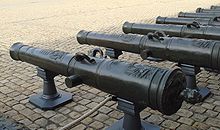|
Jean Maritz
Jean Maritz (1680–1743), also Johan Maritz, was a Swiss inventor, born in Burgdorf, Canton of Bern, who moved to France, becoming "Commissaire des Fontes" at Strasbourg (Commissioner of the King's Foundry),[1] and invented the vertical drilling machine, as well as the horizontal drilling machine for cannons in the 18th century. His inventions revolutionized cannon-making and became a key component of the de Vallière system and contributed to the development of the later Gribeauval system.  Jean Maritz first invented a vertical drilling machine for cannons while in France in 1713.[2][3] The vertical drilling method however, in which a cannon was slowly lowered over a turning drill, was very delicate, very time consuming and rather imprecise.[4]    He further developed a method for the horizontal drilling of cannons around 1734.[5][6] These methods involved the drilling of a bore from a solid casting.[5] These inventions were vast improvements over previous methods, which involved founding the cannon around a clay core, which was removed after founding, leading to imprecision and shifting of the core, and therefore poor performance.[5]   The inventions of Jean Maritz gave perfectly straight bores which could perfectly fit the ball diameter, and therefore vastly increase efficiency.[5] In the horizontal method developed by Maritz, the solid-cast cannon itself was revolved horizontally, while the drill remained static, in a method similar to that of a lathe.[4] The son of Jean Maritz, Jean Maritz II (1712-1790), who had worked with his father on the development of boring, became Inspector General of Gun Foundries in 1755.[5] He is credited with the innovation of the horizontal boring machine which can be seen in these images[7] https://www.photo.rmn.fr/archive/06-526761-2C6NU0PLJPKE.html https://www.photo.rmn.fr/archive/06-526762-2C6NU0PLJZSL.html The Maritz method would be central in the development of the Gribeauval cannon.[1][8] See alsoNotes
|
||||||||||||||||||
